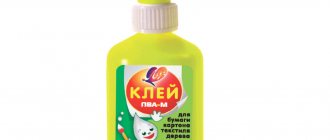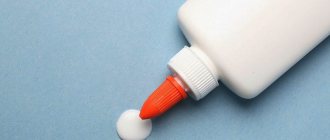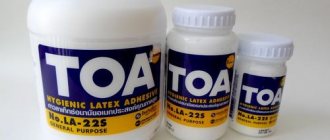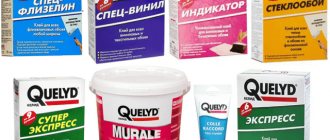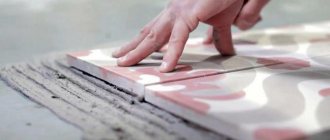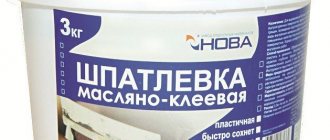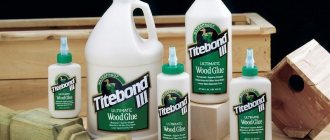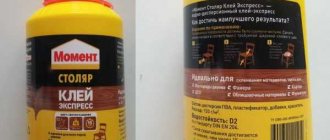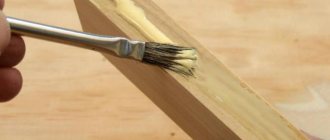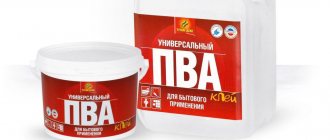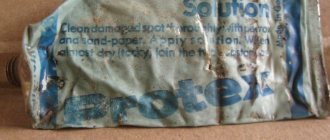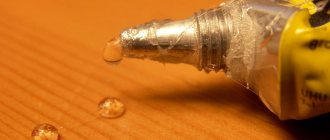Easy to use PVA glue is a universal mass, popular in everyday life and in the professional sphere. This product performs many functions and is actively used in construction, handicrafts, and repairs. The polyvinyl acetate composition is capable of connecting almost any surface and improving the quality of different mixtures. It is for these reasons that such glue is known not only to kindergarteners and schoolchildren, but also to adults who use its abilities to the maximum.
Types of PVA glue
Today there is more than one composition of PVA glue. Varieties are classified depending on technical characteristics, industry of application and other factors.
The following types of PVA are found on store shelves:
- Super (PVA-M). It contains additional components, due to which, after the glue dries, the strength significantly increases. It is recommended to use for household needs, gluing any wallpaper, installing tiles. It is packaged in small tubes with a spout and a lid, so that if desired, you can use it to make a thin seam to glue lagging elements or restore small damaged areas.
- Stationery (PVA-K). It is actively used in everyday life, usually for children's crafts. The product is available in liquid or dry form. In the first case, it is poured into small bottles, in the second, it is formed into solid PVA pencil glue.
- Universal (PVA-MB). The composition is always ready for joining cardboard, leather, wood and glass products. Ideal for processing carpet, linoleum, serpyanka, etc. The mixture is often sold in buckets.
- Construction (waterproof PVA emulsion) with polymerizing particles is intended more for compacting building mixtures, but can also be used as an independent tool for working with durable and heavy materials. In stores, this glue is found both in small tubes and in jars or buckets.
- Household (wallpaper). This variety provides good adhesion to concrete, brick, plasterboard and plaster. Also suitable for gluing heavy canvases and working with paper, foam rubber, and textiles. The product is usually sold in large buckets or jars.
Popular manufacturers
Adhesive mixtures used in construction and repair are produced by many enterprises. Everyone is trying to modify the glue in such a way as to increase its scope of application and improve its technical characteristics.
The most famous brands for 2022 include the following.
- “Ekstrakley” from “Volma” is a new reinforced slab composition. Suitable for cladding with ceramic tiles, porcelain stoneware, and natural stone.
- Tile adhesive from – dry mixtures suitable for working on vertical and horizontal surfaces. Moreover, they can be used when laying on aerated concrete and foam concrete.
- Krass PVA D3 – from a Polish manufacturer. Waterproof transparent composition, retains elasticity. An excellent solution for assembling wooden products - parquet, laminate, kitchen furniture, as well as windows and doors.
- TEX PVA is a universal polyvinyl acetate adhesive. Used for gluing wood, leather, cardboard, tiles, linoleum. It has high adhesion to various substrates.
- Epojet LV is a two-component epoxy resin, in liquid form it has excellent fluidity, and can be used for sealing seams and joints when installing plumbing products. It polymerizes with very low shrinkage and “works” at arbitrarily high humidity.
Explanation and technical specifications
PVA glue (interpretation) – polyvinyl acetate (PVA). The three-letter abbreviation comes from this component, since the adhesive mass contains about 95% of it.
In accordance with the state standard, PVA glue technical characteristics should be as follows:
- resistance to moisture, temperature changes;
- drying time on surfaces – on average 24 hours;
- load – 550 N/m;
- absence of a pronounced specific odor;
- color – uniform;
- elastic seam.
Other characteristics are listed below. They are worth considering in more detail, since these are the points that characterize such a composition as PVA. Moisture resistance is indicated by the index D1…D4.
The higher the number, the stronger the moisture resistance. Very important for carpentry work.
About epoxy glue
If we talk about epoxy construction adhesive, it is quite dangerous for humans. During its preparation, it is necessary to observe certain precautions - wear a mask and gloves. Epoxy glue can be used to glue materials such as:
- Metal.
- Ceramics.
- Glass.
- Tree.
It can also be used to seal cracks in windows and walls. Less commonly, epoxy glue is used as a paint and varnish material. The materials described above adhere well with epoxy to ceramic, glass, wood, porcelain, steel, aluminum, stone, marble and concrete surfaces. Plexiglas should also be added to this list.
To prepare epoxy, you need to take ten parts resin and mix it with one part hardener. All this must be stirred for at least ten minutes until the mass becomes homogeneous. When the glue is ready, it can be used. To do this, you need to apply it in a thin layer to the desired surface. You need to connect the elements to be glued together by applying slight pressure. Immediately after this, you need to immediately remove all excess glue using a knife. If the glue hardens at room temperature, it will take one day. Naturally, at lower temperatures the hardening process takes longer. To increase the bonding strength, you can heat the necessary elements to one hundred degrees after they have already been glued. Warming up should last several hours. Epoxy glue is also known as cold welding. It is for this reason that you need to work with it with extreme care. If glue suddenly gets on your skin, it should be washed off immediately with warm water.
What is glue made from?
Understanding production technology is not difficult if you have the necessary equipment. A completely different question is the chemical composition of PVA glue.
The following components are used for manufacturing:
- binding raw materials;
- thickener;
- adhesive dispersion;
- preservative;
- coalescent
At first, this list is surprising, but it’s enough to remember what was taught in chemistry lessons, and everything will become quite logical. When purchasing materials separately, their cost does not seem high, but when all these components are combined, the amount comes out to be considerable. Fortunately, sales of glue bring in many times more profit and all expenses are easily covered.
Glue properties
Wooden planes are connected in two ways: hot, cold. It should be taken into account that the fumes should not harm health.
Wood glue has the main properties:
- During long-term use, the properties of the connection do not change from the original ones.
- Easy to use, quick initial setting.
- Good adhesion to different planes, versatility.
- Moisture resistance.
- Increased degree of flexibility.
- When exposed to chemical elements, the properties do not change.
- Availability.
When storing, you must comply with the requirements described in the instructions. Violation will lead to loss of material properties and bonding quality.
Production technology
Enterprising people who know what PVA glue is can easily make money from its production. This is not surprising, because the technology for producing the composition is not that complicated.
The adhesive production process includes the following stages:
- Preparation of raw materials.
- Crushing components.
- Selecting the required portions and determining the weight of the raw materials.
- Processing of ingredients.
- Cooking the substance.
- Infusion of the remedy.
- Distributing the glue into portions and placing it in packaging.
Special equipment is necessarily used in production: a mortar mixer, a dissolver, a filling machine, etc. Manually, as a rule, only the placement of raw materials into the required tank occurs.
When creating glue in factories, beginning manufacturers often have problems due to the properties of this composition. The fact is that PVA has a high viscosity, which complicates the procedure for kneading, dispersing and delivering it to the packaging site.
GOST PVA glue
It is important for every buyer to know the state standard of adhesive mass so as not to waste money on a product that does not meet the quality and, accordingly, is not able to perform all its functions.
The number of PVA glue according to GOST is 18992-97 or 18992-80.
PVA glue, properties after drying
One of the signs of an adhesive composition according to the rules is its dry state. After drying, the properties are preserved, the glue forms a transparent viscous film. It can be easily seen visually. It is through this film that the materials are held together. There is no definite answer to how long PVA takes to dry. On average about a day.
The probable answer is in the instructions. It depends on the area of application, the area of smearing, the temperature of the room and the use of a hair dryer, the number of layers and the properties of the material.
Container and packaging
Today, on store shelves you can easily find PVA glue in jars, buckets, and tubes. All these containers are made only of plastic. Spouts are provided only on tubes, so when using adhesive in a bucket or jar, you additionally need to purchase a device for conveniently distributing the mixture over the surface.
As for packaging, the maximum volume of PVA glue is 10 kg. This quantity of the composition is sold in buckets. Smaller volumes – 5 kg, 2.5 kg, 1 kg, 250 g, 100 g, 70 g, 50 g.
Glue consumption
One of the important characteristics, which is also an advantage of the product, is the volume of its use per standard area. Thus, the consumption of PVA glue per 1 m² ranges from 100 to 500 g. Here everything depends on the weight of the materials being joined, as well as the characteristics of their surface.
Best before date
The glue can be stored for 12 months. But the manufacturer makes some of its varieties, for example, building composition, more durable and doubles this period of time - up to 24 months.
After the expiration date, PVA glue acquires an unpleasant and strong odor, so even if you forget about the expiration date, it will not be difficult to distinguish an unusable product.
About liquid nails
Liquid nails are called high-strength adhesive compositions. It is made on the basis of rubber, to which polymers are added. Thanks to this composition, the surfaces stick very firmly to each other. When glued together, they can withstand heavy loads. It is worth noting that liquid nails must contain special clay. Its presence is determined by the gray color of the adhesive mass. If the color of liquid nails is white, then this indicates the absence of this component. Consequently, the properties of this glue deteriorate by an order of magnitude.
One drop of liquid nails can withstand a fifty kilogram load. But the main advantage lies in the fact that the surfaces do not warp after gluing. Moreover, such glue is not afraid of rust and does not deteriorate. There are two types of liquid nails:
- The first type is created using an organic solvent.
- The second type is made on a water basis.
The first type of nails is neoprene. This type of glue has an unpleasant and strong odor and high adhesive strength. Also, the adhesive composition, created on an organic basis, is not afraid of low temperatures. Therefore, it is used for external construction work.
The second type of nails is also called acrylic. This glue is practically odorless and is considered absolutely harmless. Therefore, this type of glue can be safely used when carrying out construction or repair work indoors. In most cases, water-based liquid nails only work well with surfaces that have high porosity.
In general, the following surfaces can be glued with liquid nails:
- Panels.
- Moldings.
- Plywood.
- Drywall.
- Ceramics.
- Lathing.
- Chipboard and fibreboard.
- Foam panels used for insulation.
- Plastic, aluminum and glass materials.
You can also glue wood with liquid nails. This adhesive composition allows you to work with plastered surfaces, concrete and stone. However, liquid nails are incompatible with marble and polyethylene. Very often they are used as a sealing agent during the installation of plumbing fixtures, arranging ventilation and when sealing cracks.
So, liquid nails can be used to glue almost anything. The glued surface should be left alone until completely dry. This will take no more than forty minutes.
Is it worth using expired composition?
Consumers ask this question quite often. Although the shelf life is given a long time, people still miss it, and when they feel sorry for the money spent and don’t want to throw away the composition, they try to use it faster.
It is difficult to say whether it is possible to use expired PVA glue. It all depends on the purpose for which the composition needs to be used and how long ago its expiration date expired. So, if the product is literally a month or two out of date, it is still quite possible to use it as a primer or glue paper or cardboard.
But if the permissible storage period expires by more than 3 months, the product will simply lose all its properties and will not be able to combine even simple materials. In addition, lumps may appear in expired glue or its consistency will resemble jelly, which will make use not entirely convenient.
Reasons and rules for dilution
What is the best method to use if the glue has thickened? The easiest way is to dilute it with water, adding it literally gram by gram, so as not to make the composition too liquid. Water will not deteriorate the properties of office and household adhesives. All other types of PVA, especially construction grade, are strictly prohibited from being diluted with water; they will lose their adhesive function. How to dilute this composition is indicated on the packaging; acetone is usually suitable for this.
If you make the composition more liquid, its consumption will decrease. You can also dilute PVA to obtain a primer. It is most common to add 1 part glue to 5 parts water to create a high quality primer for walls and ceilings. Sometimes it happens that the glue, on the contrary, needs to be thickened to enhance its adhesion to the surface or to prevent deformation of thin materials. The composition is easily converted into a thicker state: you just need to leave the jar open for a day, and the excess moisture will evaporate.
Manufactured in Russia, famous brands
The number of PVA glue manufacturers in Russia is not as large as it might seem at first glance. But consumers are quite satisfied with the range of products they present on the market.
The most popular adhesives today are Expopribor and Moment. They are sold at competitive prices, but each product has its own distinctive features. They are described in more detail below.
PVA glue Expopribor
The popular PVA roller glue from Expopribor belongs to the premium class. It is intended for work with paper, cardboard, wood, fabric, leather and ceramics when thin and neat seams are required. This product is easy to use, economical in use and does not pose a threat to human health, since it contains no toxins.
The glue is sold in standard packages with a ball applicator, due to which the layer is always distributed evenly. A spring-loaded ball made of stainless steel serves to protect against leakage of the mass in any position of the packaging.
Glue Moment PVA
The adhesive mass is available in different versions - for paper and cardboard, with protection from moisture, for working with wood, leather and other materials. The name of the glue speaks for itself - it bonds surfaces instantly. But you shouldn’t take this too literally, since it still takes some time for it to dry and, at the same time, reliably connect objects.
Many consumers conduct various experiments with PVA Moment glue, adding it to building mixtures. The result, oddly enough, is often pleasantly surprising, although unsuccessful experiments also occur in practice. The product is packaged in small tubes, buckets and containers. Therefore, if necessary, you can easily find a convenient option for yourself.
Classification by type of gluing and purpose
Types of glue are primarily distinguished by the type of gluing.
- Drying agents - casein, PVA, carpentry. In this composition, the adhesive is mixed with a solvent. As the latter evaporates, the glue forms a strong bond between the elements. The drying time depends on the purpose of the composition and the nature of the material.
- Non-drying adhesives – hot melt adhesives, rosin. This mixture must be melted before gluing. The moving melt fills the gap between the materials and forms a chemical or diffusion bond with them. As it cools, the connection becomes strong.
- Polymerizable – epoxy resin, cyacrine, BF glue. The composition polymerizes when cured or dries. Such a bond is one of the strongest, since in this case new intermolecular bonds appear.
Polymerizing adhesives are often classified as drying adhesives.
Separation
by purpose determines not only the nature of the materials being connected, but also the requirements for the bond formed.
- for household needs - gluing cardboard, paper, plastic, fabric, wood sheets and other thin materials with a loose structure;
- for skin;
- compositions for wood - the structure is not only loose, but also fibrous, which must be taken into account;
- stationery - only for paper and cardboard;
- for rubber and similar materials;
- for metal - also used for gluing other smooth surfaces, such as ceramics and glass, as well as for car repairs: splicing frames, glass;
- for ceramics - a variety of tile adhesives designed to work in different temperature conditions;
- universal - like Moment glue, with high adhesion to any material;
- optical – a special composition for joining optical glass products;
- conductive low-resistance - based on silver;
- conductive high-resistance with graphite;
- construction - this includes mixtures used in the installation of reinforced concrete and metal structures.
There are adhesive compositions used for medical purposes. Such mixtures form a semi-permeable film that does not cause allergies. They are used to treat small wounds.
Reviews of some formulations
People who regularly use PVA glue leave reviews about it quite often. For example, let’s take the compositions described above – Moment and Expopribor. Consumers see the same advantages and disadvantages in them.
As for the positive aspects, the masters note:
- efficiency;
- resistance to water, mechanical, thermal, ultraviolet influences;
- economical consumption;
- a wide selection of containers in which products are packaged;
- no pungent odor;
- the ability to be used as an independent product or as an element of a building mixture;
- not explosive.
Speaking of cons, consumers tend to only complain about the short shelf life. Otherwise, no negative aspects were found.
Polyurethane sealants
Polyurethane sealants are an elastic, adhesive, sealing mass on a polyurethane basis that retains its elasticity for a long time. This sealant can be used for gluing and sealing almost any materials: metal, wood, stone, varnished sheet metal, plastic, ceramics, concrete.
Polyurethane sealants have good adhesion and guarantee strong bonding of surfaces that is not destroyed even during strong earthquakes up to magnitude 5.
• They are resistant to corrosion.
• Harden upon reaction with moisture.
• Can be painted and easily varnished.
• Have a quick setting.
Due to the fact that polyurethane sealants contain harmful caustic substances, you should remember that when working with them you should not allow them to come into contact with exposed skin.
They are sold in standard original packaging with a weight of 310 ml, also available in cardboard boxes or in an aluminum bag weighing 600 ml.
PVA rating
Separately, it is worth considering several products that are often purchased and used for different purposes. These include:
- Universal PVA Moment Joiner. An excellent option for working with wood of any species. PVA glue was included in the rating due to its quick drying, reliable connection of parts and the absence of marks on surfaces after work.
- Expo device Slide-Stick. The product is more often found in small bottles. It is usually used for small jobs with paper, cardboard, and wallpaper. The composition is characterized by frost resistance and efficiency.
- Beam PVA-M. The product for gluing various surfaces is packaged in standard bottles with dispensers. You can use it at home, in the office or on the street, since this mixture is not afraid of temperature changes.
- Super PVA D2 moment. A universal option with increased adhesion strength and reliability. The composition is ideal for construction work.
- Moment Super PVA D3. Moisture-resistant adhesive for wood, veneer, chipboard and other similar materials is characterized by strength and reliability, like the previous product. The most important thing is that it contains no solvents or toluene.
- Expo device White Glue. Glue without a specific odor is usually sold in compact bottles with an elongated spout. It holds different surfaces together, but during repair work it is better to combine it with more effective mixtures.
- OfficeSpace PVA glue Universal. The product is resistant to frost and moisture. It is often sold in small jars without dispensers, so for use you will need to additionally purchase a brush.
PVA glue, which is better?
Buyers often wonder how to choose from the variety available. Experienced specialists in these cases point to PVA-Universal. This choice is explained by the possibility of using the composition both in handicrafts and in construction.
It is perfect for working with paper and cardboard, improves the quality of cement and other mortars, and also helps, if necessary, to hang wallpaper of any type.
What glues PVA glue
White or transparent PVA glue can reliably connect not only paper and cardboard, which every person has become accustomed to since childhood. Depending on the type of composition, it can glue:
- wood, metal;
- carpet, linoleum;
- foam rubber, fabric, serpyanka.
Where is it used?
The most common area of using PVA is children's creativity. The adhesive mass is actively used in kindergartens, schools, and clubs. And the main advantage of glue here is that it can not only connect parts, but also add durability to gouache.
In modern production, building mixtures are also prepared from PVA glue, where it serves as a sealant. In addition, the composition is used for gluing wallpaper, installing tiles and parquet, etc. Its strength is high enough to hold such products not only on the floor, but also on the walls and ceiling.
Classification of adhesives by purpose
According to their intended purpose, construction adhesives are divided into several types:
- For tiles. This glue has good adhesion. It is easy to work with, it is not afraid of moisture and mechanical stress. In addition, this composition has good air conductivity. Tile adhesive can be cement, one-component, or two-component.
- For the floor. This adhesive is used for gluing a wide variety of floor coverings. This includes linoleum, cork, parquet, and laminate boards. The adhesive composition for the floor is water-dispersed. Also, such glue can be prepared using solvents. It also comes in two components.
- For wallpaper. This adhesive composition is always selected taking into account the type of wallpaper - paper, vinyl, glass wallpaper, non-woven wallpaper. Wallpaper glue for each type of wallpaper has a similar name. Wallpaper glue can also be universal.
- Sealants. As you can guess from the name, this type of construction adhesives is used to seal doors and windows. They seal cracks and cracks. Sealants are acrylic, silicone, polyurethane.
Instructions for working with glue
For each PVA glue, the instructions for use are simple and clear. When unpacking the composition, you should be sure to read the insert inside, which talks about the use of this particular type of adhesive. If instructions are not provided in the kit, it is better to work with PVA according to standard rules:
- The surfaces to be glued must be cleaned of dirt and dried before applying the adhesive.
- The mass is distributed with a brush or, in rare cases, with a spatula with teeth.
- The composition should be applied evenly and not too thickly.
- The second layer, if required, may be applied only after the previous one has dried.
- It is better to press the parts to be glued tightly against each other and hold for several minutes.
Temperature of storage, work with PVA and operation
It is also important to consider the rules for storing and using PVA glue. The temperature at which this composition is used cannot fall below -20 degrees Celsius. The maximum indicator is considered to be +100 degrees - in this case the mass begins to collapse. The same applies to the storage of PVA.
The glue can be used both indoors and outdoors. Since it is moisture resistant, it is allowed to work with the product during precipitation (not heavy), without fear of deterioration in the properties and quality of the result.
How long does it take to dry?
Among other things, every consumer needs to know how long PVA glue takes to dry. This period of time is different for each purpose of using the composition. So, when joining the paper, 15 minutes is enough for complete drying. If construction and repair work is carried out with glue, the average drying time is 1 day.
It is important to remember that a thin layer of adhesive dries much faster. Therefore, it is better to distribute the product evenly using special devices. In addition, to speed up the drying of the PVA, you can use a hairdryer or microwave to increase the temperature.
How to dilute PVA glue
People often ask whether PVA glue can be diluted with water, because this component is ideal for solving the problem of a thickened composition. In some cases this is allowed. The most important thing is to add liquid literally gram by gram.
This ingredient does not impair the properties of household and office glue. But for other types of PVA, it is worth using acetone as a diluting component, because water in any form contributes to the loss of their adhesive function.
How to thicken PVA glue
Along with methods of diluting the composition, craftsmen are also interested in how to make PVA glue thick. Here things are simpler.
To thicken the mass, simply leave it in an open container for a day.
During the specified period of time, excess moisture will evaporate and the mixture will become ready for use.
Opuses about His Majesty Glue. Part one - introductory
There are areas of knowledge that “cannot be measured by a common yardstick...”. In principle, in my “home” field, colloidal chemistry, any fundamental concept can easily be placed under this direction, be it adsorption (with adsorbents) or adhesion (with adhesives). To be honest, the thought of writing about glue never occurred to me. But when readers in every topic related to polymers start asking to talk about adhesives, you inevitably start thinking about it (and of course you want to retort to “everything must be glued with superglue”). Adhesion and adhesives are a very broad topic, so I still decided to tackle it, but break the story into several parts. Today the first part is introductory and informational. To find out what makes glue stick, what kinds of glues there are, and which glue is best suited for gluing _____ (fill in what you need), we traditionally go under the cat (and bookmark it).
Before I begin my story, I would like to make a small digression:
In Memory of the Colloidal Chemist
My supervisor of thesis practice liked to respond to the attacks of colleagues “there are no smart students now...” with the phrase “there are no bad students, there is a teacher who is in the wrong place.” More and more often I find myself agreeing with this phrase. Students sense sincerity and mastery of the subject matter and “vote” with respect and attendance. Belarusian science, after the collapse of the USSR, generally became a thing in itself, strange and in some places even wild. It is not surprising that many academicians of Belarus, as a rule, are “widely known in narrow circles”, non-public people, etc. Even though the work was interesting. But more often than not, dry biographical information on some homemade html website of the institute cannot even approximately tell what a person was like. So Doctor of Chemical Sciences, Professor Foma Fomich Mozheiko was a special man. Without false modesty, we can say that the entire Soligorsk Klondike was built with the help of his hands and bright head. I had the opportunity to meet this person for the first time when I was passing the candidate minimum in colloid chemistry, after which we began to communicate closely and in a friendly manner. Considering that graduate students at our research institute were treated defiantly “in no way,” this made an impression on me... and, perhaps, precisely thanks to the meeting with this old man, who could explain in a nutshell the essence of a complex process and convince me that our common field - Queen of Chemistry, I am now writing a chemical article on Habr, and not wiping my pants during development or testing... So, in all honesty, all articles on colloidal topics should have a remark “in memory of F.F. Mozheiko,” because this particular person was one of my Teachers. May your memory be blessed, F.F.!
Glue has been used by man since ancient times; it can be assumed that as soon as primitive man stuck the flint tip of his spear to the shaft with the help of bitumen or pine resin, the practice of gluing began.
In ancient times, everything that came to hand was used as glue. Most often, products of animal origin were used that initially had adhesive properties (fish scales, animal veins, etc. substances after heat treatment). It is worth noting that there are areas in which organic adhesives are still actively used. Wood glue, casein glue, wallpaper pastes. Despite the abundance of synthetic (=chemical adhesives), the mentioned options are still in operation and firmly occupy their rightful niche as environmentally friendly and cheap adhesive substances. By the way, many modern adhesives are called synthetic resins only in honor of the fact that resin (a sticky substance found in pine trees and other plants) was one of the first widely used adhesives. The whole concept of bonding rests on two fundamental phenomena of colloidal chemistry - adhesion and cohesion (okay, three, also surface tension).
Adhesion (from Latin adhaesio - sticking) in physics is the adhesion of the surfaces of dissimilar solid and/or liquid bodies. Adhesion is caused by intermolecular interactions in the surface layer and is characterized by the specific work required to separate the surfaces.
Related in both sound and meaning to adhesion is the concept of cohesion, which sometimes some people like to confuse.
Don't confuse adhesion with cohesion
... which is the reason for the existence of things in the state in which we are accustomed to seeing them (i.e. in the form of pieces, drops, etc., and not scattered among molecules). This phenomenon is called cohesion:
Cohesion (English cohesion from Latin cohaesus - “connected”, “linked”) is the connection between identical molecules (atoms, ions) inside a body within the same phase. Cohesion characterizes the strength of a body and its ability to withstand external influences. Cohesion is the action or property of mutual attraction between like molecules. It is an intrinsic property of a substance, determined by the shape or structure of its molecules, that causes a change in the distribution of electrons of the molecules as they come closer together, creating an electrical attraction capable of forming microscopic structures.
The difference between these fundamental concepts of colloidal chemistry is best illustrated by the example of water droplets that form on a window pane when it rains.
The picture shows the confrontation between the “elements”, each of which is engaged in its own business of forming the picture of the world that is familiar to us. The shape of the drop is given by surface tension. The force of gravity (earth's gravity) pulls the drop down to flow from the glass. The forces of adhesion and cohesion fight together against this inexorable force. Cohesion is the first to manifest itself, since it already takes place in the drop of water itself. Neighboring molecules stick together and form the very drops that then slide picturesquely across the glass. Cohesion binds individual molecules into ensembles. But adhesion attaches ensembles in the form of drops to the glass, makes them hold on to the glass, “pulls up”, forcing them to resist movement under their own weight. Moreover, cohesion is stronger than adhesion, otherwise drops would not be able to form, i.e. rainwater would simply spread in an even layer over the glass, forming a kind of oil film on the water. By the way, if you carefully observe the glass during rain, you will notice that drops roll down the already existing “water paths”. This is due to the fact that falling drops of water, due to cohesive forces, try to stick to the water that is already there, and not to the glass. The mentioned tracks, by the way, are formed due to the fact that when drops hit the window, water molecules are torn off from the passing drops and captured by the glass.
What does all this have to do with adhesives? And the most direct thing. Adhesion and cohesion are the main active factors in adhesives. Let's say you want to join two pieces of wood, A and B, using glue B. Here you need three different forces: the adhesive forces that can hold A and B together + the adhesive forces that hold B and B together + the adhesive forces that can hold glue B together.
If everything is clear with the first two forces, then I will give a small explanation about the last one. The best example is two pieces of loaf glued together with jam or jam. Jam is a classic natural glue (I’ll say a few words about them below), made from sugar and water. Moreover, it is quite effective. When using fairly strong bread (or crackers) and the right “mother’s” jam, it’s quite possible to hold two pieces together by greasing only one corner. Good jam has fairly strong internal cohesive forces (so it is difficult to pull it out of the jar, especially pear jam), but adhesion to other surfaces is also excellent. Therefore, it is difficult to tear apart a glued sandwich without destroying the loaf (this happens most often if you move the layers to the side, rather than applying force perpendicularly). But if the jam “has a weak internal cohesive core,” then it doesn’t matter how well it sticks to the loaf. The two halves will not be able to stick together and will fall apart under the influence of gravity.
Another antagonistic example: water and a piece of iron. Both objects are, under normal conditions, very poorly suitable for gluing, but for different reasons. Water - because its adhesion forces are great and it sticks perfectly to any surface, but due to very weak cohesive forces, these surfaces do not adhere firmly to each other and are easy to separate. In a piece of iron, on the contrary, there are incredibly strong cohesive interactions (responsible for the connection of atoms), and it is such a “thing in itself” that it is almost impossible to achieve adhesion from it to any other external material. A test of internal cohesive forces can be the ability to separate a material into pieces. A “piece” of water can be easily separated from the total mass with your finger/spoon, etc., but try separating a piece of cast iron with your finger :).
From the above, the conclusion is that the main thing in the nature of glue is its strength
hesion, and in the nature of gluing is the force
of
adhesion. Since adhesives, as a rule, are quite specific substances, the effectiveness of many of which has been tested by the experience of many generations, I will focus on the phenomenon of adhesion (glue, by the way, can also be called an adhesive). To date, several different competing/complementary theories have been developed that try to explain the appearance of the adhesion phenomenon:
Despite the abundance of hardware, there is still no single answer to the question “what makes glue stick?” But this is not so surprising when you consider how many different types of glue there are and how many different ways to use them. It is believed that for each individual adhesive and for each individual surface on which it is used, there is an individual combination of different factors that hold these objects together. The process of studying the processes of gluing continues today, because even in the 21st century, when “spaceships roam ...”, we still do not fully understand what makes substances stick to each other. Therefore, we have to operate with assumptions and generalizations. Taking this into account, it turns out that there are four main possible mechanisms of bonding: through adsorption, chemisorption, mechanical attachment and diffusion.
Adsorption is the effect of surfaces sticking to each other due to ultra-low attractive forces (the so-called van der Waals forces (by the way, reader cck7777 mentioned that it would be more correct to say “van der” as in de Nederlandse taal
), a common name for all intermolecular forces). These forces, in addition, are further divided into electrostatic interaction forces (Kizom forces arising between permanent molecular dipoles), polarization forces (Debye intermolecular forces between permanent and induced dipoles) and dispersion interaction forces (London forces between instantly induced dipoles). Dipole = two charges, equal in magnitude and opposite in sign, located at a distance from each other that is very small compared to the distance to the point of observation. Well, then “opposites attract, etc.” This is what all electrostatics are based on (and with it all adhesives). The forces of intermolecular interaction, by the way, appear when the participants (atoms and molecules) are at a very close distance (less than 1 nm).
When applying glue, the surface of the parts to be glued is wetted and the objects stick to each other. For the glue to work, the surfaces must be as degreased as possible (for the adhesive to spread over the surface) and the glue is evenly distributed in a thin layer. In fact, this process is reminiscent of the adhesion of millions of microscopic magnets (which are played by glue molecules and molecules of the materials being glued together).
A small note regarding perfectly smooth surfaces
The gecko can be considered an interesting adhesion artifact. This is a lizard that can calmly move along various vertical surfaces (in Marvel parlance, “like Spider-Man”). Even Aristotle indulged in idle thoughts about the cause of this phenomenon. Modern scientists have studied this issue for quite a long time, gradually discarding the vacuum theory (= suction due to pressure difference), the theory of biological glue (= releases an adhesive substance), etc. As a result, they settled on electrostatic interactions (caused by contact electrification), rather than van der Waals or capillary forces. The reason for the phenomenon was the bristles covering each of the paws in millions. Each bristle is about 0.1 millimeters long (twice the thickness of a human hair). For every square millimeter of the tarsus there are up to 14,400 bristles (~1.5 million per cm2). Each seta diverges at the end into 400-1000 branches and each branch ends at the end with a triangular plate 0.2 micrometers wide. Those. A gecko's foot, with an area of about a centimeter square, contacts the surface with approximately two billion endings.
B. Photograph of a gecko's bristles.
B. Photograph of one gecko bristle. D. Photograph of a branch at the end of a bristle. Recent research shows that it is this geometry of the legs and the associated electrostatic forces (multiplied by billions of endings) that add up to a result that can support the weight of a gecko on the ceiling.
Clarification from reader Rikkitik:
Here is an article about material that imitates gecko feet from 2016. In short, the most interesting thing was not how to attach it, but how to tear it off without losing functionality, that is, to achieve reusability of the connection.
The villi are subject to seemingly mutually exclusive requirements—this is something researchers encountered already at the beginning of the 21st century.
The fibers must be thin in order to penetrate into the smallest gaps and pits, and at the same time durable so as not to come off the sole with every step. They should be flexible and relatively easy to stretch to reach the ridges of a complex, rough surface, but not so flexible that they can easily be separated from that surface, rather than dragging behind the sole like chewing gum. Artificial structures made from such fibers must be as stable as possible, not come off the foot and withstand a huge number (up to a million) of sticking and unsticking cycles. The space between the villi should not become too contaminated with dust collected from the surface, and the villi themselves should not stick together, since both of these sharply reduce their ability to adapt to a difficult surface.
It would be surprising if the military did not take advantage of all this. In May 2014, DARPA demonstrated its development of Geckskin (Project Z-Man), a hand attachment that allows movement on vertical surfaces.
True, five years have passed, and for some reason nothing more is heard about Geckskin. Perhaps because it is classified, or perhaps because there is no result.
Geckos and Darpa are all there somewhere with them. And our best illustration of the forces of intermolecular interactions can be a perfectly ground surface. Every turner-miller should know about such a thing as Johanson tiles, or plane-parallel end measures. These tiles are polished and ground in such a way that they stick together quite strongly if they are placed with their smooth edges against each other. In the picture, thirty-six tiles are held together by atmospheric pressure and van der Waals forces:
For those who don’t believe that this is possible, I recommend watching a visual demonstration (clickable):
Adsorption is inexorably followed by chemisorption, but despite the similarity of names, the essence of the phenomena is radically different. Chemisorption - adhesion occurs due to the formation of chemical bonds between the glue and the substances being glued. In fact, when bonded, a new chemical is formed. During diffusion, gluing occurs due to the mutual penetration of material molecules into each other. The glue molecules mix with the molecules of the surfaces being glued and form a strong bond. Finally, mechanical adhesion occurs when the adhesive penetrates microcracks and cavities in materials and then physically holds them. For clarity, the picture shows the numerical values of the energies for the various forces that occur during gluing.
It is obvious that the best adhesion is formed in the case of chemisorption interaction between the substances being glued, although this is not always possible to achieve (but it is necessary to strive).
Types of adhesives
From all of the above it follows that any glue will exploit one or another of the principles described above. Moreover, in the case of adhesives, as in the case of geckos, researchers, as a rule, also do not have a consensus of opinion. But this, in principle, is not so important, because quite a lot of practical experience has been accumulated that makes it possible to easily select the optimal adhesives and adhesive compositions for a wide variety of materials. There are many divisions of adhesive substances, I will give the simplest, based on their chemical nature:
Moreover, I would like to note the fact that to this day we are mainly actively exploiting developments that were almost a hundred years old. Judge for yourself based on the brief chronology:
1920
1930s
: urea formaldehyde, pressure sensitive adhesive tapes, phenolic resin adhesive films, polyvinyl acetate (PVA) were introduced. wood adhesives
1940s
: nitrile phenol, chlorinated rubber, melamine formaldehyde, vinylphenol and acrylic polyurethanes were synthesized
1950s
: epoxies, cyanoacrylates, anaerobic adhesives were introduced 1960s:
polyimides
, polybenzimidazole, polyquinoxaline were introduced
1970s
: acrylics were introduced second generation adhesives, pressure sensitive acrylics, structural polyurethanes
1980s
: active development of thickeners for thermoset resins, introduced water-soluble epoxy resins, contact adhesives, moldable and foam hot melt adhesives
1990s
: introduced polyurethane-modified epoxy resins, curable thermoplastic materials, UV and visible light curable adhesives were proposed
2000s
: water-based adhesives were synthesized, one-component and two-component solvent-free adhesives were actively being developed
In most cases, polymers are used as synthetic adhesive compositions, so I recommend reading along the way two of my thematic tutorial articles (Letter from a chemist to a 3D printer. Solvents for plastics and protection against them + Returning the birdbird to the girl or RTFM for identifying plastics at home), although to get used to the “polymer” terminology and see basic information on polymers.
Today, the main development of “custom” adhesive compositions is along the path of increasing environmental friendliness (often, by the way, to the detriment of the strength of the connection). Structural and industrial compositions are not particularly susceptible to this, but in general they still use traditional, time-tested options. So, look in the table below for your materials to be joined and remember the type of glue you need.
A bonus is a comparative review of the strength characteristics of various types of adhesives. Sometimes it's useful 
Visual comparison of the strength characteristics of joints obtained using different types of adhesives
Signatures: CA-cyanoacrylates, MS-modified silane adhesives, PU-polyurethane adhesives, MMA-methyl methacrylate adhesives, UV-curable adhesives
This concludes the introductory part; in the following, we will move on to consider specific types of glue and optimal conditions/materials for its use. Ask questions that concern you in the comments - then there is a high probability of answers appearing in the next part.
N.B.
Continuation of the topic:
Opuses about His Majesty Glue. Part two - Viva, cyanoacrylate! Viva, superglue Opuses about His Majesty Glue. Part three - polyurethane vs cosmic cold Opuses about His Majesty Glue. Part four - silicones
Whether there will be a next article depends on the habra community, because subj.
Important!
All updates and intermediate notes from which habra articles are then smoothly formed can now be seen in my telegram channel lab66
. Subscribe so as not to wait for the next article, but to immediately be aware of all the research
Subscribe so as not to wait for the next article, but to immediately be aware of all the research
Used Books
Handbook of Rubber Bonding, Ed., B. Crowther, Rapra Technology Ltd, Shrewsbury, UK, 2000. DE Packham, Handbook of Adhesion, Longman Scientific & Technical, Harlow, UK, 1992. DJ Dunn, Engineering and Structural Adhesives, Rapra Review Report No.169, Rapra Technology Ltd, Shrewsbury, UK, 2004. Skiest, I. The Handbook of Adhesives, 3rd ed., Van Nostrand Reinhold, New York, 1990. Satas, D. The Handbook of Pressure Sensitive Adhesives, 2nd ed. ., Van Nostrand Reinhold, New York, 1989. Petrie, E. M., Handbook of Adhesives and Sealants, McGraw-Hill, New York, 2000.
How to make PVA glue at home
If they don’t want to spend money on packaging from the store, people try to figure out how to make PVA glue themselves. Of course, there are no particular difficulties in this, but the ingredients will need to be selected exactly:
- 4 g glycerin;
- 1 liter of distilled water;
- 100 g wheat flour;
- 20 ml of ethyl alcohol;
- 5 g gelatin.
The process of cooking the adhesive composition is as follows:
- Soak the gelatin in plain water, as indicated in the instructions on the package, and leave for a day.
- Combine all components, except glycerin and alcohol, in a separate container and place in a water bath until completely melted and transformed into a homogeneous and thick mass. At the same time, do not forget to stir the mixture.
- Add the remaining ingredients to the resulting composition, mix thoroughly and remove from the water bath.
- Wait for the mixture to cool and immediately begin using it or place it in a container and close the lid tightly.
Consumers are also interested in how to make PVA glue colored and whether it is even possible. Oddly enough, such an experiment can be safely carried out without any special skills.
The following ingredients can color the adhesive composition:
- watercolor paints;
- gouache;
- nail polish;
- iodine;
- brilliant green;
- pencil lead;
- marker/felt-tip pen (draw a thicker spot on the paper and drop glue there).
You can choose the quantity of these components yourself, depending on the desired color saturation. Having combined the PVA and the coloring element, the mass must be thoroughly stirred using a wooden spatula or a toothpick, if its volume is minimal.
Application technology
Before applying the sealant, standard surface preparation is performed (cleaning from grease, moisture, debris and dust). The sealant is applied either directly from the tube or using a special hand gun. The initial film is formed in 1-1.5 hours, and final hardening with a layer thickness of 3 mm occurs within 20 hours.
The shelf life of polyurethane sealants in original packaging, fully protected from moisture at temperatures from 0 to +20°C, is more than 9 months. Once the sealant package has been opened, a long shelf life is unacceptable, as the sealant will lose its properties.
What to replace
Along with basic information about the adhesive mass, it is advisable to consider what can replace PVA glue made in Russia. This will definitely come in handy for people living abroad. Indeed, in some countries, for example in France, Spain, Italy, there is an excellent selection of compounds for any purpose.
Here are just a few of them:
- Lydiakol.
- Cleopatre Cleocol.
- Pattex colle vinylica universal flex.
In our country, another type of glue intended for a specific purpose is considered an excellent alternative to PVA. For example, if you need to hang wallpaper, you should look for a bottle with the inscription “wallpaper”; on products for joining wooden surfaces it is directly indicated – “for wood”, etc.
For light work (with paper, cardboard, small pieces of wallpaper, etc.), purchasing glue is sometimes not necessary. In this case, PVA is advantageously replaced with paste prepared at home from flour or starch and water.
Area of use
The tool is most widely used in children's creativity. PVA is very popular in schools, kindergartens, clubs, and development studios. Your child will not need special clothing to work with it. You can remove stains in a regular washing machine. The glue will easily hold paper, cardboard, thread, fabric, etc. When mixed with gouache, glue is used to paint on canvas, because such paint will be durable and will not fade.
PVA is used in construction work: from wallpapering to installing parquet, laminate, and tiles. The glue is suitable for impregnating wood to give it water-repellent properties. By adding 5-10% PVA to a regular cement mortar, the latter's waterproofing ability seriously increases, as does its ductility and adhesion to the base. 70 g of PVA per 10 liters of base mass is added to the plaster. This helps the coating dry quickly and also allows the mortar to adhere better to the wall.
Imported analogues
There is a prejudice that supposedly in foreign countries people have no idea what PVA is. This does not mean that they have no glue at all. It’s just that they have their own compositions, the properties and tasks performed are as similar as ours, some are even better. And conditionally excellent foreign analogues of PVA glue are discussed below.
Korean PVA glue Leeho
PVA glue 28 ml produced in South Korea with two Leeho dispensers is a product with excellent bonding properties. The adhesive mass always lies evenly on the surface to be treated, without forming foam or clumping the material. The composition dries quite quickly.
Two dispensers are provided in the product for greater consumer convenience. One of them is thin and is used for gluing small parts, the second is wide, designed for working with large areas. The dispensers are reliably protected by caps, so there is no need to worry about the product drying out in the tube.
German Brauberg
Brauberg PVA glue can be universal, suitable for any job, or intended for a specific task. Regardless of the purpose of use of the composition, it is characterized by resistance to frost and moisture. The glue is produced exclusively from high-quality raw materials, which confirms its effectiveness and reliability.
Brauberg products work best with paper, fabric and cardboard. It is especially often used in the office or when posting advertisements on the street.
Production Iran
Iranian products are famous for their high strength and unsurpassed quality. For example, PVA 801 Mashhad glue is used to work with surfaces that must withstand heavy operating loads. They are convenient for processing wood, plaster, and putty. Not less often, consumers add the composition to mortars. In addition, the glue works well when laying ceramic tiles or creating a floor screed.
This product has quite a lot of advantages, which is not surprising. But the most significant of them can be called: the resistance of the seam to aging, increasing the elasticity of building masses, preventing the appearance of cracks in the floor screed, the absence of an unpleasant odor, and frost resistance.
Chinese "Contact"
Among all the variety of Chinese products, PVA glue “Contact” 250 g is especially popular and respected. It is usually sold in compact bottles with a dispenser. The composition itself is moderately thick, which is very good when working with paper and cardboard, as they do not become limp.
The product resembles Soviet glue in its properties and qualities. Users claim that this product is a really worthwhile PVA, which, if desired, can be ordered in the country where it is produced.
Classification of adhesives by composition
As for the classification of construction adhesives by composition, they are as follows:
- Cement. Used for laying tiles and thermal insulation. This glue must be diluted with water before use.
- Plaster. They are used when it is necessary to glue plasterboard and decorative elements made of gypsum to the wall surface. Gypsum adhesives are also used to level walls.
- Water-dispersed. Used for gluing wooden and polymer surfaces, when laying parquet, when gluing plastic tiles, when laying linoleum.
- Vinyl. They are used when wallpapering walls, decorating rooms with decorative details, laying laminate flooring, and so on.
- Acrylic. Used in construction, industry and other areas.
- Rubber or rubber. Used for gluing rubber, wood, leather, felt, ceramics, glass.
- Polymer. Designed for repair and construction work.
Comparison of PVA and bustylate
Bustilate and PVA, what is the difference? In conclusion, it is worth answering one more popular question. They are often asked by neophytes because they mistakenly consider these compositions to be completely identical. But in reality there is a difference between them, although not very significant, because their basic functions and properties are still similar.
First of all, it is worth noting that PVA is glue in its pure form, and bustilate is the same PVA, but with the addition of various impurities. Just due to the additional components in the composition, the second has two main advantages over the first:
- The shelf life of bustilate is twice as long as that of PVA.
- Bustilate has higher adhesion.
At the same time, for children's crafts and repairs in rooms where children are present for a long time, it is recommended to use PVA. And the reason for this is its environmental friendliness compared to bustylate.
In terms of resistance to moisture, heat and frost, both compositions are the same. In addition, the rules for applying and removing them from surfaces are identical.
Bustilat is an old Soviet-developed glue, but PVA is much older, although it is far ahead in popularity. Marketing played a major role. The leader was also given an advantage by the environmental friendliness of polyvinyl acetate. The toxicity based on it is more determined by the properties of solvents and additives.
Advantages and disadvantages
The glue is very convenient to use, easy to apply and does not spread. When it is thick, it can be diluted with water, although this does not apply to all types of PVA. How long does it take for the product to dry? Drying time depends on the ambient temperature, area of application and is 12-24 hours, which is a low indicator for adhesives.
Other advantages of the composition:
- does not include substances harmful to the body, approved for use by children from 3 years of age;
- safe in contact with skin, you can use the product even without gloves;
- is not flammable or explosive;
- resistant to mechanical stress;
- plastic, elastic, so the adhesive seam does not deteriorate under dynamic loads;
- withstands several cycles of freezing and thawing;
- can be used even in enclosed spaces due to the absence of unpleasant odor and harmful fumes;
- has low consumption - 100-500 g/sq.m. m;
- has excellent adhesive properties - up to 550 N/m;
- does not collapse under the influence of ultraviolet radiation;
- perfectly fills all cracks, cracks, gaps, holes;
- sold in a variety of packaging sizes;
- can be used independently or as a base for primers and putties;
- dried glue does not shrink and does not deform the glued product.
It is not difficult to wipe off glue stains from different surfaces. Despite its solubility only in chemicals, PVA is washed off with plain water. The product also has disadvantages. The glue is not stored for too long - up to 6-12 months, after this time it can deteriorate irrevocably. If there are additional chemical components, the degree of safety may vary, and you will have to use personal protective equipment to work with the glue.
Useful life hack
As the author of this article, I can give one practical piece of advice that I have used many times when replacing slate over large areas. Unsuccessfully driven nails or screws leave extra holes, which do not greatly affect the aesthetic appearance, but threaten to spoil the functionality of the slate covering.
In such cases, I dilute M400 cement in a small volume with ordinary white PVA glue until it becomes a homogeneous paste. Not very liquid, but not thick either, as it sets within 30 minutes. I cover the holes, it’s cheap and cheerful, and there’s no need to invent anything. Keeps for many years. If you tint, the leaks won't last forever until the slate "rots."
PVA glue is a truly unique product. Although they first learned about it at the beginning of the last century, today it is actively used for various purposes. Modern manufacturers in Russia and abroad are constantly trying to improve adhesives in order to offer the consumer something more interesting and profitable, and they are doing it quite well.
Even more functionality of the product is given by the possibility of its use both independently and in combination with additional components and modifiers that improve properties.
Adhesives for different types of work
Each individual construction process requires adhesives with different properties that are needed to interact with various materials, be it wallpaper, linoleum, parquet or wall panels. All construction adhesives can be divided into several groups:
- Parquet adhesives - when carrying out this type of work, fireproof adhesives are required, such as PVA, which can be used to ensure bonding to concrete, wood and other surfaces. They are also quite economical and quite effective.
- Floor adhesives - synthetic substances that have good properties and are environmentally safe are often used for gluing linoleum and cork flooring. They are also cost effective and have a drying time of one to three days.
- Wall and ceiling adhesives - this type is very similar to parquet adhesives, as they require increased safety when used indoors. Such adhesives are excellent at bonding to concrete, wood, as well as chipboard, drywall and much more.
- Special adhesives - as an example, we can take polyurethane foam, which is also an adhesive that has additional properties of thermal insulation, filling voids and bonding. This also includes “liquid nails”, which do not need to be applied to the entire surface, but a point distribution is used to install any structure.
By purchasing adhesives from well-known manufacturers, you can be sure of the quality of the product and its reliability and durability. Please note that each package describes in detail the purpose of a particular adhesive. Just a huge selection in modern construction supermarkets will allow you to choose what you need specifically in your situation.
Wood glue: types and composition
Wood glue is based on animal protein. The type of glue is determined by its type.
Based on flesh
The main component of the flesh composition is the hidden layer, the protein of the animal skin. The basis is cysteines, which combine ligaments to connect different systems. This glue is produced in the form of tiles, powder, and flakes.
In order for the adhesive mass to obtain the desired consistency and meet all the declared properties, it is necessary to strictly follow the instructions during preparation, observing the proportions. According to the instructions, two parts of purified water are added to one part of the dry substance, then deoxidation occurs over the course of 12 hours, and the liquid must be heated to 60–65 degrees.
The composition contains gelatin and oligopeptides. This indicates the safety and naturalness of the glue.
The adhesive properties are particularly durable and reliable. The dried layer takes on a light tone.
